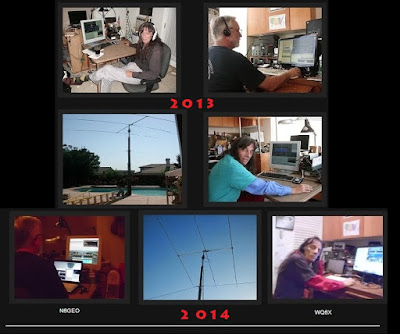This last weekend was INTENDED to be a dual-OP operation during the 2019 IARU HF Championship. Dual-OP'ing allows me to give a thorough test to BOTH sides of things;
in Concord, as well as Fallbrook. A major goal was to reprise a pair of dual-Wins, as was done
in the 2018 IARU GiG as I shared my "IARU Blast from the Past" blog ([
CLICK HERE] to read that.)
Being the "night guy" at NX6T, I fired things up shortly after the 12:00z radiosport start (5am).
For purposes of the IARU GiG, 40 was WIDE OPEN to the USA and Canada; within an hour Hawaii and Japan were in the log. Unfortunately, a Saturday morning business meeting required that I head out to Pleasant Hill at 7:30. Fortunately, the morning man, K4RB was B-I-C at Fallbrook shortly after that. Because the station setup @ W7AYT was ready to go, I put a half-dozen QSOs in the WQ6X Log before heading out the door.
 |
| N 6 K I + N N 6 X + N 6 E E G |
By 22:30 (3:30pm) while NX6T's day crew was running pileups, I was back in Concord, B-I-C
as WQ6X, firing up on 20-meters. Band condx. made this part of the IARU GiG basically a USA and Canada affair, with
KH7/WH7 thrown in as a "Bonus"; reading the after-contest soapbox comments pretty much confirmed that experience.
At 01:12z it was time to brave 40, which turned out to be the same as 20, just on a lower frequency. Eventually
CE2LR,
LU0HQ made it to the log, along with
PX2A and
CT9ABO an hour later, followed by
EF8R and then
RK3A,
ES5R,
VK2GR,
VK5ARG and
SN0HQ; all with the Lazy 8JK Sloper pointing more-or-less N-E.
 |
| The FT-1000mp running in Stereo-CW mode |
At W7AYT, I have settled in on a consistent equipment configuration as well as the outdoor antenna configuration; for better or worse. While WQ6X will probably not take a 1st-place (other than for EB section) from this QTH, I am always amazed at being able to add "deep" European callsigns to the contest log from W7AYT's DX-Vortex QTH.
The 8JK-sloper was the mainstay antenna; then again, occasionally the onsite CH-250 vertical would present a lower S/N ratio on receive, although I would still transmit on the sloper. If they can hear
me better on the sloper, I Xmit on the sloper; if the CH-250 is better for receive then I use that - it
may make no logical sense that a vertical should have a lower S/N ratio; however what IS, IS.
 |
| WQ6X - STN1 (Listening) + N6ERD - STN2 (40-m Ssb) |
As the evening wore on VK4CT, P44W, TI7W, JH3FUK and 8N3HQ made it to the log before
I finally had to call it quits for some sleep before my 2am shift @ NX6T. As it turns out, N6ERD
was busy filling the Ssb log, so I got another 90 minutes sleep before it was time to take over on
Cw, finishing the contest.
At 10:30z, I spent the final 90 minutes of
the IARU GiG alternating between 80 and 160 meters, as the e-coast stations were enjoying their morning coffee. In the midst
of the 80-m run,
JE6RPM slipped through
the noise followed by
CE2LR,
VE7DZO
and
RU0HQ.
During the last hour of the IARU contest a switch to 160 brought a bunch of West Coast stations followed by KH6CJJ.
After the obligatory 10 minutes on 160, a shift
was made back to 80-meters where NX6T was rewarded with
LU8DPM,
JA1CJP,
VK2BJ &
KH6CJJ.
Then, switching to 40-meters, Asia stations were everywhere, beginning with
RM0M,
BH1NGG,
BG7OAJ &
E2HQ; not to mention the dozens of JA stations - most with BiG signals - and then,
VK6LW.
K7RVX was
the final QSO @ 11:59:42z.
For me, the IARU GiG is always frustrating as being a mere 24 hour event, I am just getting
warmed up when its time to shut it down. This year, NX6T made a few changes BE-4 IARU
start; most specifically, replacing WINTEST with the nearly-identical looking DX-Log software.
Looking at the stat screens and the data entry layout, I could hardly discern the difference.
Another change for the 2019 IARU GiG @ NX6T was the re-introduction
of a 25+ yr-old classic Kenwood TS-950SDX
at STN-3, the Mult-station (in place of the usual Elecraft K3 at that OP position). When the IARU GiG was over N6ERD took the TS-950 out of service, presumably to save-the-day, another day.
Many contest operators thought this weekend was more like an NAQP contest, rather than
a Dx-oriented contest. As WQ6X, I put a
whopping 19 IARU zones in the log. Nevertheless,
it would seem that WQ6X may have been the top CW-only station in the East Bay (EB) section,
and amazingly, possibly for the Pacific Division as well - it has happened before.
Based on the 3830 Scores listing, it would seem that
NX6T was top HP multi-OP multi-mode station in the San Diego (SDG) section and possibly for the Southwest Division as well; how well we did for
IARU Zone-6 is a different question altogether.
Did YOU work the 2019 IARU HF Championship?
Is NX6T or WQ6X in YOUR LoG?


















































